
















































PUBLISHER
James R. Baker
GENERAL MANAGER
John Rusnak
EXECUTIVE EDITOR
Andy Walgamott
EDITOR
Chris Cocoles
CONTRIBUTORS
Scott Haugen, Tiffany Haugen, Tim E. Hovey, Cal Kellogg, Joe Sarmiento, Jake Sisco
SALES MANAGER
Paul Yarnold
ACCOUNT EXECUTIVES
Tawna Lucero, Tom St. Clair
DESIGNERS
Gabrielle Pangilinan, Lesley-Anne Slisko-Cooper
PRODUCTION ASSISTANT
Emily Baker
DIGITAL STRATEGIST
Jon Hines
ADMINISTRATIVE ASSISTANT
Katie Aumann
INFORMATION SERVICES MANAGER
Lois Sanborn
ADVERTISING INQUIRIES ads@calsportsmanmag.com
CORRESPONDENCE
Email ccocoles@media-inc.com X @CalSportsMan Facebook.com/californiasportsmanmagazine
ON THE COVER
As California faces a second consecutive year of ocean and inland river salmon fishing closures, an alternative is targeting kokanee (landlocked sockeye salmon) at several productive lakes around Northern and Central California, headlined by New Melones, Whiskeytown and Stampede. (CAL KELLOGG)
MEDIA INC PUBLISHING GROUP
941 Powell Ave SW, Suite 120 Renton, WA 98057 (800) 332-1736 • Fax (206) 382-9437 media@media-inc.com www.mediaindexpublishing.com







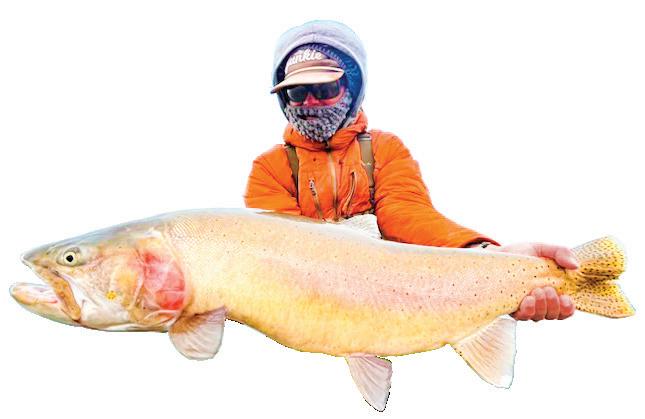
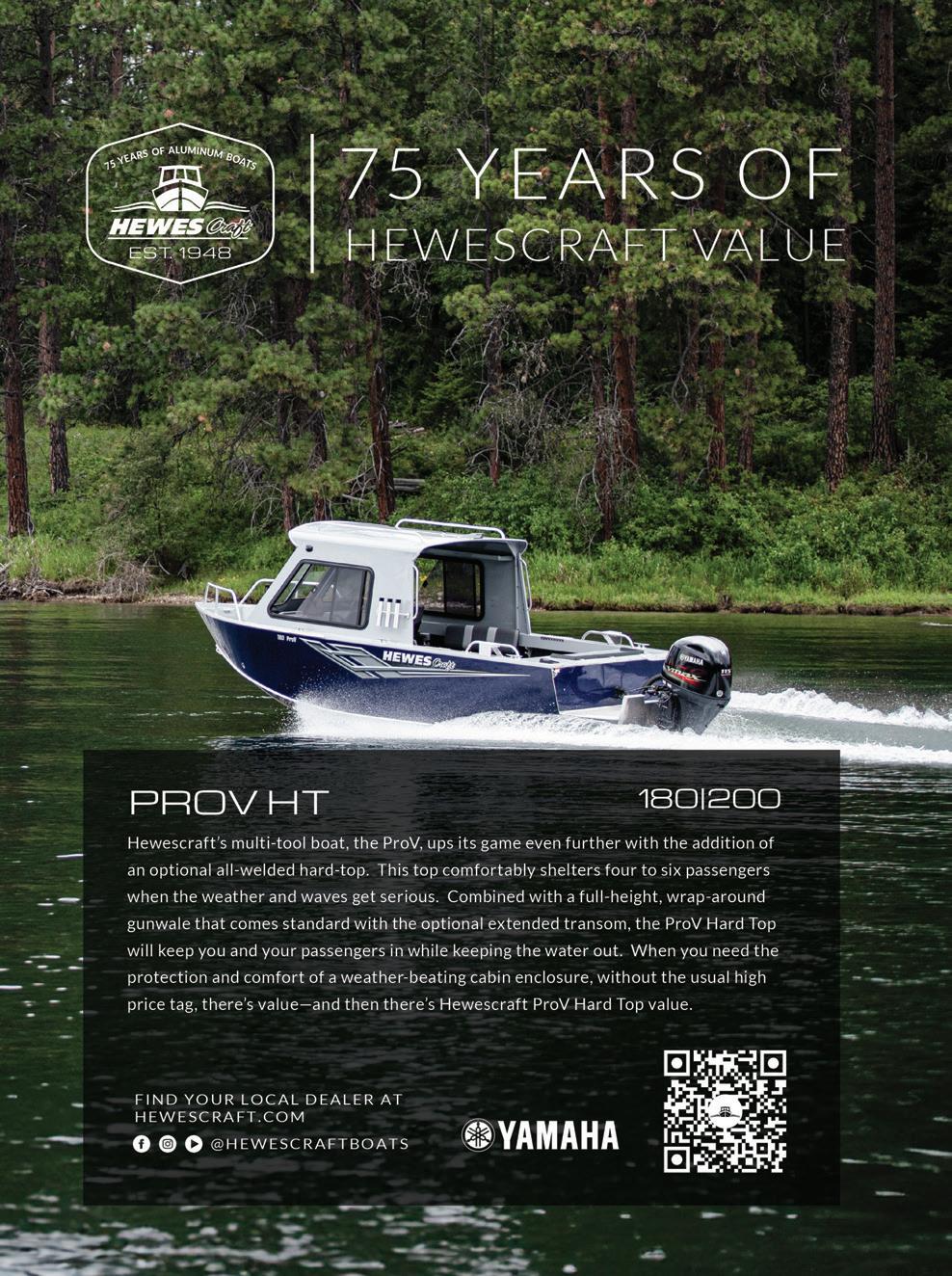
Northern California’s Gold Country features plenty of outstanding trout fisheries. Of the popular Mother Lode lakes, Camanche is arguably the best spring rainbow destination for plenty of pansize beauties and a chance at a whopper. Cal Kellogg is a regular visitor and shares what works to load up your stringer.

29 BEAT THE HEAT TO CATCH MORE TROUT
Summer is just around the corner, and so are soaring temperatures that send trout to cooler waters in lakes and rivers. In the first of a two-part series in our From Field to Fire feature, Scott Haugen figuratively takes a deep dive into where to find and how to target fish in stillwaters as the thermometer rises. And for how to get maximum flavor out of your catch, chef Tiffany Haugen shares a trout and tzatziki sauce recipe!
37 THE SALMON ALTERNATIVE
53 Protecting Wild California: USFWS on why dumping aquarium fish in the wild is devastating to native species
57 Saltwater angler’s new love for mini jigs
67 NorCal gun dog trainer’s tips for sniffing out big game antler sheds
As California endures a second consecutive season without Chinook fishing in the Pacific and inland rivers, an alternate way to get your salmon fix is by targeting kokanee – landlocked sockeye that are ubiquitous in several lakes in the Golden State. Cal Kellogg details how to load up on these delicious, feisty fish, as well as the three top reservoirs for big kokes this year.
45 FISH WITH MORE FINESSE
Longtime angler Tim Hovey has learned a lot over the years, both in his own trial-and-error moments and spying what other anglers are doing. Watching a wise old angler fool bass after bass with a very specific finesse tactic opened up a lifetime of catching for Tim, who shares the secret.


In my younger years, I used to love reading the San Francisco Examiner’s fishing report. Longtime Bay Area outdoors writer Tom Stienstra would list charter fishing boats’ performances in terms of the number of anglers aboard and how many salmon they caught. From the Wacky Jacky in San Francisco to the Emeryville-based Sea Wolf, many days back in the early 1980s saw limits for each customer.
I never realized how much I took for granted – and also years in the sportswriting business working away from home – that salmon were once plentiful enough to fill the coolers of happy and hungry anglers after their day on the water.
King salmon indeed have endured good years and bad over the late 20th and early 21st centuries, but with back-toback ocean season closures in California waters, it’s a reality check that, sadly, has left many in the fishing industry in an I-told-you-so mode.
At the conclusion of the Pacific Marine Fishery Council meetings in Seattle in early April to set this year’s seasons, the PFMC
agreed to accept the California Department of Fish and Wildlife’s recommendation to shut down ocean fishing for a second consecutive year. The projected return of Sacramento River fall-run Chinook, while slightly higher than last year, is still historically low at 213,622 fish.
When several fishing industry representatives gathered for a news conference at San Francisco’s Fisherman’s Wharf shortly after the final determination was made, there was a mix of frustration over perceived lack of action from state and federal agencies, depression about another year of lost income, and concern for the future of these remarkable fish in California.
“I was talking to a local sporting goods store manager who was saying that (with) salmon season closing from one (year) to the next, he now has to temporarily lay off employees in this small town to be able to just get by until the next duck season happens. There are also the impacts that nobody ever talks about,” said Scott Artis, Golden State Salmon Association executive director, who spoke directly to California’s leading political voices.
“If we want to prevent closures and if we want to ensure salmon have a sustainable future for all that was mentioned here, we need to demand more flows in our salmon rivers. Governor (Gavin) Newsom, I am begging you and I’m asking you to get flows in our rivers to save salmon, and everybody who directly and indirectly relies on that fishery.”
Also standing on the dock that day was Andy Guiliano, who owns and operates fishing charters out of Emeryville. Unlike the captains of my youth who were constantly filling up Stienstra’s fish report with limits of salmon, Guiliano faces another spring and early summer of no Chinook trips.
“Annually, California has devoted a tremendous amount of resources protecting reptiles, amphibians, birds and marine mammals. Perhaps someday soon Sacramento will offer some support and resources to those who make their living on the water,” he said. “For without it, all that will remain will be photographs, newspaper clippings and imported farmed fish.”

-Chris Cocoles
“King salmon are Northern California’s big game fish – ocean bright, a brilliant silver color, a thrill to hook and land and as delicious as any fish in the ocean,” says Bay Area charter boat owner and operator Andy Guiliano, who faces a fishing closure for the second straight year. “This marks the fourth complete closure since 2008. Toss in the Covid-19 pandemic and you have the toughest period in Northern California sportfishing history. Salmon represent one-third of our revenue annually, and the closure is (not) recoverable.” (U.S. FISH AND WILDLIFE SERVICE)


4 NorCal Trout Angler’s Challenge, Pardee Lake; anglerspress.com/events/norcal-trout-anglers-challenge
4-5 Shasta Lake Team Kokanee Derby; kokaneepower.org
11 Gray Lodge Wildlife Area Kids’ Fishing Day, Gridley; (530) 846-7505
6-19 Archery-only spring wild turkey season dates
6-19 Additional junior spring turkey season dates
17-19 Clearlake Oaks Catfish Derby, Clear Lake; clearlakeoaks.org/derby/register-for-the-derby
18 Lassen Sportsmen’s Club Junior Kids’ Fishing Derby, Susan River Memorial Park, Susanville; facebook.com/ LassenSportsmensclub
24-26 Hangman’s Cash Bonus Weekend, Convict Lake; (760) 935-4301
24-June 24 CrowleyLake Perch Derby; crowleylakefishcamp.com, (760) 935-4301
25 Arrowhead Lake Association Fishing Derby; ala-ca.org/ fishing_derby.php
JUNE
1 North Fork Boosters Club Children’s Fishing Derby, Willow Creek, North Fork; northforkboosters.org
7-8 Finest Annual Trout Invitational Tournament, Crowley Lake; crowleylakefishcamp.com
8 New Melones Team Kokanee Derby; kokaneepower.org
8 Greg Marks Youth Fishing Derby, Shaver Lake; shaverlaketrophytroutproject.org/youth-fishing-derby
15 Davis Lake Derby; (530) 832-0270
16 Father’s Day Fishing Derby, Yuba and Downie Rivers, Downieville; sierracountychamber.com/event-5165256
22 Bridgeport June Trout Tournament; Bridgeport Reservoir and East Walker River; bridgeportfish.com, (760) 616-4214
22 Juniors Kokanee Derby, Pardee Lake; kokaneepower.org
29 TroutFest (free for kids 12 and under), Hot Creek Hatchery; monocounty.org
29-July 7 Mono Village’s Annual Summer Fishing Derby, Upper Twin Lake; (760) 932-7071
For a list of upcoming bass tournaments, go to nrm.dfg. ca.gov/ FishingContests/default.aspx.


CAMANCHE LAKE OFFERS YEAR-ROUND RAINBOW TROUT ACTION, AND MAY IS PRIME TIME
Large rainbow trout in excess of 8 pounds lurk in the waters of Lake Camanche, one of the most popular of Central California’s Mother Lode lakes. (CAL KELLOGG) By Cal KelloggAs I pedaled my Hobie kayak into the dense veil of earlymorning fog, sticking close to the shoreline and listening to the sounds of high-powered bass boats zipping past unseen further offshore, I contemplated the good news/ bad news proposition I’d immersed myself in on Lake Camanche.
From one perspective, I knew I was going to catch plenty of trout, and if recent past adventures were any indication, then some of the rainbows would be big, strong fish that would test my tackle.
From the other perspective, I had a long, 90-plus-minute pedaling session in front of me before I reached the spot far up the Mokelumne River Arm where I’d been experiencing the best trolling.
I locked into a brisk rhythm of pedaling, trailing a single black and white Speed Spoon behind the kayak. On the way through the main
lake body, I hooked one good fish but lost it before I could bring the battler to the net.
As I reached the area where I’d concentrate my fishing efforts, the fog was just starting to lift. I stopped for a quick cup of coffee from my thermos

and swapped my power-trolling rod for a pair of hybrid leadcore outfits rigged for pulling soft plastic Trout Trix Minnows. I’d had stellar results pulling the minnows on previous trips from the surface to 10 feet deep and between 1.6 and 2.2 mph.
 Bruce Wicks tempted this bruiser pulling a small Rapala just under the surface. (CAL KELLOGG)
Bruce Wicks tempted this bruiser pulling a small Rapala just under the surface. (CAL KELLOGG)
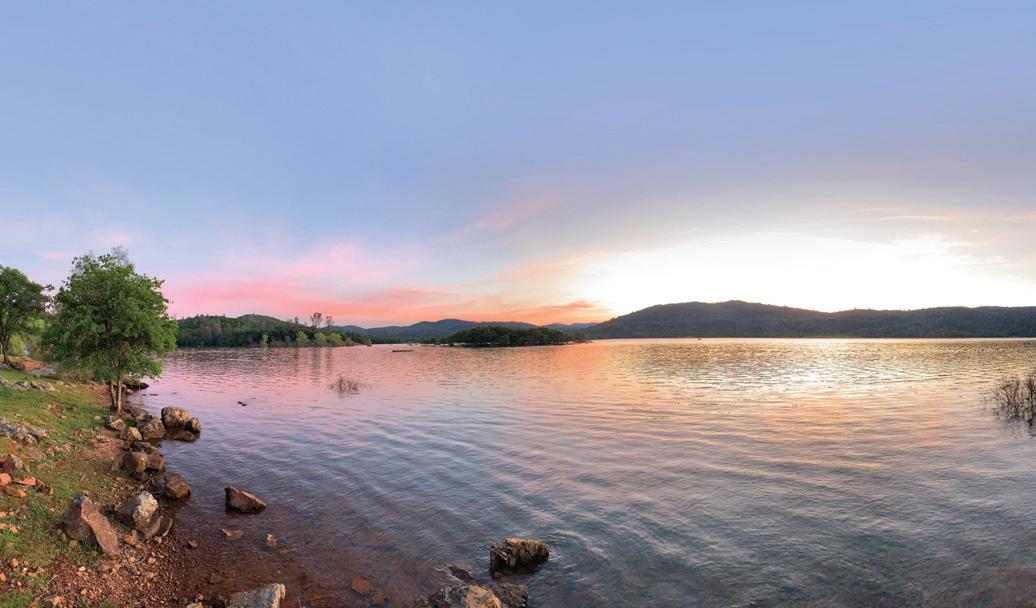

A stark white minnow had been performing the best, but I rigged one rod with a white bait and one with a natural-colored minnow to test whether the preference of the trout had changed.
The white bait was spooled out and running 5 feet deep as I started to let out the second minnow. But before I got the second bait all the way out, the white minnow got crushed and the rod jerked into a deep arc.
After snatching the rod from the holder, I started fighting the trout. First, the powerful fish came to the surface for a series of thrashing jumps before diving deep and bulldogging against the resilience of my softtipped leadcore rod.
In the midst of this pandemonium, I became aware that my second rod had gotten slammed too. At times the rod
locked into its holder, bent deeply and the reel relinquished line grudgingly.
At other times the rod went straight and the line went slack as the unseen trout surged toward the kayak. It was wonderful to have a double hookup perhaps five minutes after arriving at my trolling grounds, but I was too busy battling trout number one to worry about what trout number two was doing. All I could do was to keep pedaling and hope the hooked trout didn’t foul each other!
I’d like to say it was all due to superior skill and superhuman reflexes, but in reality, luck and good fortune were on my side and I managed to land both fish. The first one was about a 4.5-pound rainbow that I quickly released back into the chilly January water. The second trout, which should have come
unbuttoned multiple times as it swam around on an often-slack line, turned out to be about a pound bigger.
I’d been seriously trolling for less than 10 minutes and had already brought about 10 pounds of rambunctious rainbows to the net. It’s action like this that brings me back to Lake Camanche time after time!
The Mother Lode region is special, offering a unique mixture of history and natural beauty. There are myriad opportunities for the outdoor enthusiast, from hiking and biking, to hunting and fishing.
For the trout angler, the Mother Lode is dotted with famous lakes, such as Don Pedro, New Melones, Pardee, Tulloch, Amador and Camanche. Each of these reservoirs has unique qualities
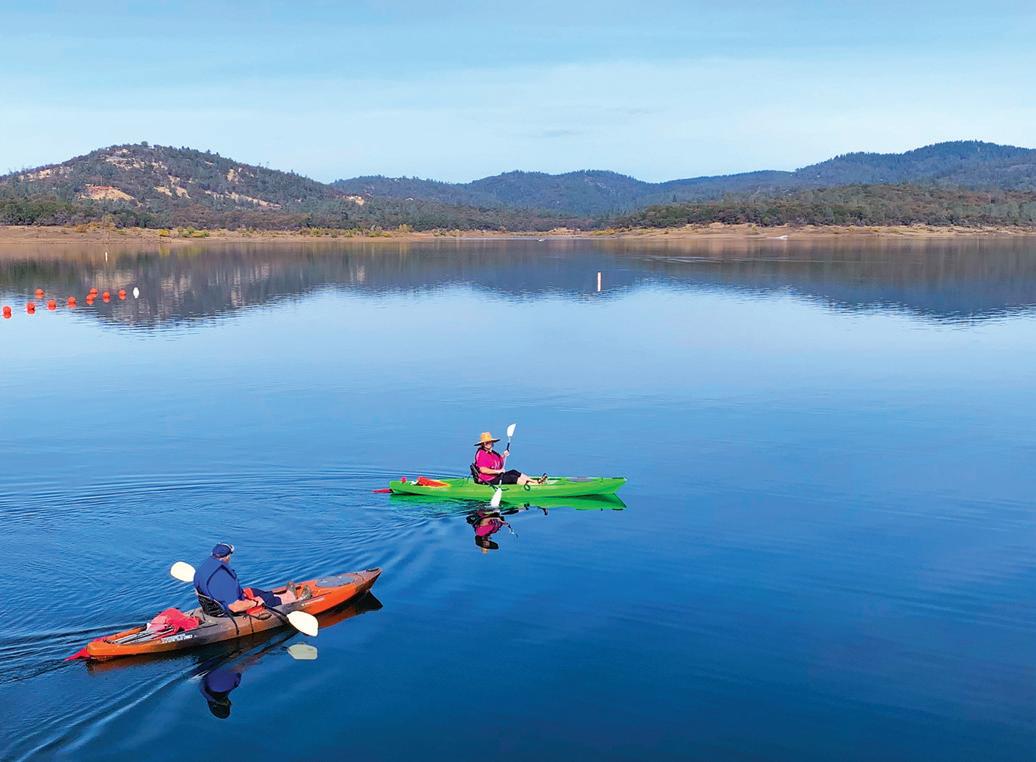





in terms of the trout fishing they offer. Which is the best overall trout lake in the Mother Lode? I’m going to go out on a limb and declare that Lake Camanche should wear the crown.
For starters, Lake Camanche offers outstanding year-round action for rainbows that range up to and beyond the 10-pound mark. Since the lake is situated an easy 24-mile drive northeast of Stockton, access is a snap.
The lake was originally formed by the East Bay Municipal Utility District to provide water to the eastern part of the Bay Area and to produce hydroelectric power, but a third goal was to create a recreational destination in the San Joaquin Valley. EBMUD oversees concessions at the lake, which include boat

Soft plastics such as this Trout Trix Minnow have proven to be very effective at Camanche when the trout aren’t energetic enough to grab fast-moving spoons. (CAL KELLOGG)

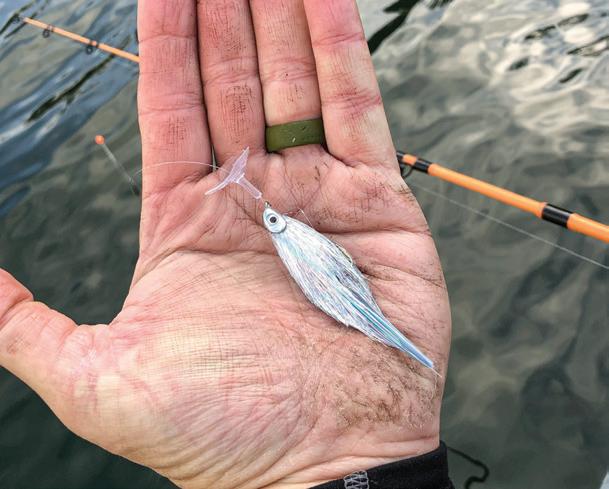
Shad-imitating flies like this Metal Head are a great choice for Camanche holdovers, which feed on the lake’s prolific population of the baitfish. (CAL KELLOGG)
launching, camping and other services, plus a robust trout planting program. More than 50,000 pounds of rainbows are annually planted in the reservoir between October and June. Some of the trout are standard California Department of Fish and Wildlife catchable planters, but the bulk are 2- to 10-pound, high-quality rainbows from the Mount Lassen Hatchery.
Lake Camanche is deep enough to sustain the trout throughout the hot season, resulting in a robust holdover population of rainbows that spend the summer lurking in deep water gorging on threadfin shad.
Camanche is a medium-sized impoundment compared to other foothill reservoirs. It was formed with the completion of Camanche Dam in 1964. At full capacity, the lake holds 417,120 acre-feet of water. This translates to 12 square miles of surface area and roughly 53 miles of shoreline.
In terms of shape, Camanche consists of a large, egg-shaped main body punctuated by several islands and two arms. The Mokelumne Arm is the larger of the two and offers
terrain reminiscent of most canyontype reservoirs, with rocky shorelines dropping rapidly into deep water.
SEASONS AND TACTICS
Each of the four seasons offers a somewhat unique trout fishing opportunity at Camanche. When surface temperatures drop back into the 60s during the fall, trout plants, which are suspended during the summer, kick back into gear. As if the influx of planters isn’t enough, this is also the time when holdovers that spent the summer in deep water return to the surface, sleek, muscular and essentially wild.
If you want to get in on holdover action, the months of November and December are prime time. And during the dog days of winter – say, from Christmas through March 1 – trout numbers in the lake are constantly climbing due to aggressive planting. Surface temperatures are chilly this time of year, and the trout tend to spread out. You can find good action in most areas of the main body and the river arms, yet areas hosting exceptional action do occur. When the water is at its coldest, the
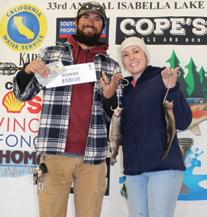


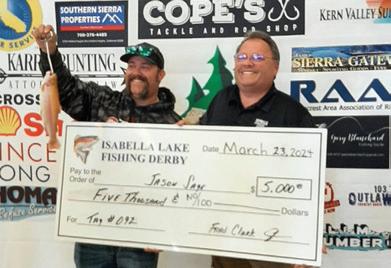


Congratulations to all of our anglers who landed tagged trout during the 33rd ANNUAL


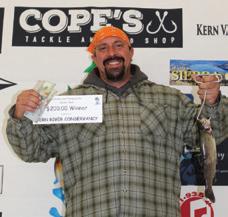


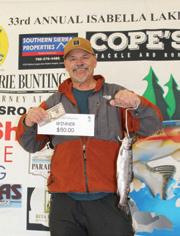

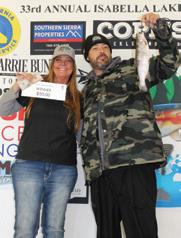
We look forward to seeing everyone next year!

best fishing tends to take place from about 10 in the morning until 2 or 3 in the afternoon. I favor sunny winter days to dreary overcast days because the action tends to improve with a rising surface temperature. Days with sunny skies and little to no wind see the best bump in surface temperature.
Spring months, including May, attract big numbers of trout anglers to Camanche. This is the time of the year with the maximum number of holdovers and planters in the lake and the surface temperature is low enough for the fish to remain near the surface and near shore, giving boat, small-craft and bank anglers the best chances of hooking up.
Summertime is probably the least popular season for targeting Camanche trout because they go deep. Trollers working with downriggers
and enterprising bait anglers who seek out deep water score some nice rainbows during the warm season, but deep-water action doesn’t appeal to a large cross section of anglers.
From fall through spring, bank anglers tend to score just as well as boaters and kayakers at Camanche. Access is outstanding for bank anglers and when the water is cool, there are always plenty of trout holding along the shoreline. This is particularly true in the dead of winter and early spring, since nearshore waters tend to be the warmest.
As with most locations, PowerBait is the most effective offering for a bank angler to employ when trying to take home a limit of rainbows, but there are other approaches that work well too.
Hiking and fan casting with
Kastmasters, Krocodiles and other dense casting spoons in shad-imitating colors will certainly produce results for energetic bank anglers. A sleeper approach for the bank angler is rigging one spinning rod with a casting spoon and another with a clear water-filled bubble teamed with a fly.
Light-colored baitfish-imitating flies work well, but black, brown and olive offerings do too. The key to scoring with a bubble and fly is filling the bobber completely with water, making long casts and varying the retrieve until you figure out what the fish want on any given day.
Among trollers, Camanche has a well-deserved reputation for being a power-trolling lake, where the rainbows respond to spoons and minnow plugs pulled from 2.7 to 3.5 mph. Most anglers go with shad-





pattern lures, but bright orange and pink plugs and spoons work well too.
The speed-trolling approach works great all year long when the trout are in a mood to chase bait, but if it’s your only approach, you’ll struggle at times.
If the fish happen to be lethargic when you visit, perhaps due to a passing cold front or during the full moon period, it’s important to have some slow- to medium-speed trolling approaches up your sleeve.
I’ve done very well at Camanche all year long pulling Trout Trix Worms, Trout Trix Minnows and Metal Head Trolling Flies, along with a variety of small spoons that work well when trolled from 1.8 to 2.2 mph.
Grubs in the 2- to 3-inch range and when teamed with Power Eggs have a solid following at Camanche because they produce some handsome ’bows when trolled from 1.5 to 2 mph.
As with most lakes featuring
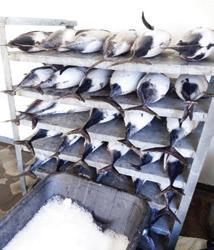
rainbow trout, an old-school set of flashers or a dodger paired with half a threaded nightcrawler can be a real trout slayer when pulled slow to medium fast.
Temperature dictates lure depth. If I have a surface temperature of 65 or below, I assume there will be active rainbows just below the surface early, late or anytime there is chop on the surface or when the light level is low, such as during periods of overcast.
If I have a surface temperature at or below 65, I seldom pull lures deeper than 15 feet, as the most active trout tend to hold near the top of the water column.
As spring gives way to summer, trust your sonar and utilize your downriggers to keep your offerings 5 to 10 feet above the main biomass of trout and bait.
Lake Camanche is one of those places
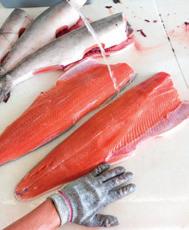
that you always have the chance of hooking a double-digit trout. For this reason, you need to be ready. Make sure your line is fresh and free of rough spots. Double check your knots and make sure your drag is set properly.
Finally, have a plan for landing an exceptionally large trout should you be lucky enough to hook one. Don’t rush the net job. Take your time, wear the fish down and only make your move with the net when the fish has its head up.
Remember, most really large trout that anglers lose are either lost during the first few seconds of the fight due to a drag that is too tight or right at the boat due to a bungled net job! CS
Editor’s note: Cal Kellogg is a longtime Northern California-based outdoors writer. Subscribe to his YouTube channel Fish Hunt Shoot Productions at youtube .com/user/KelloggOutdoors.


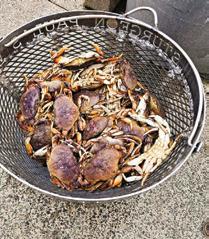



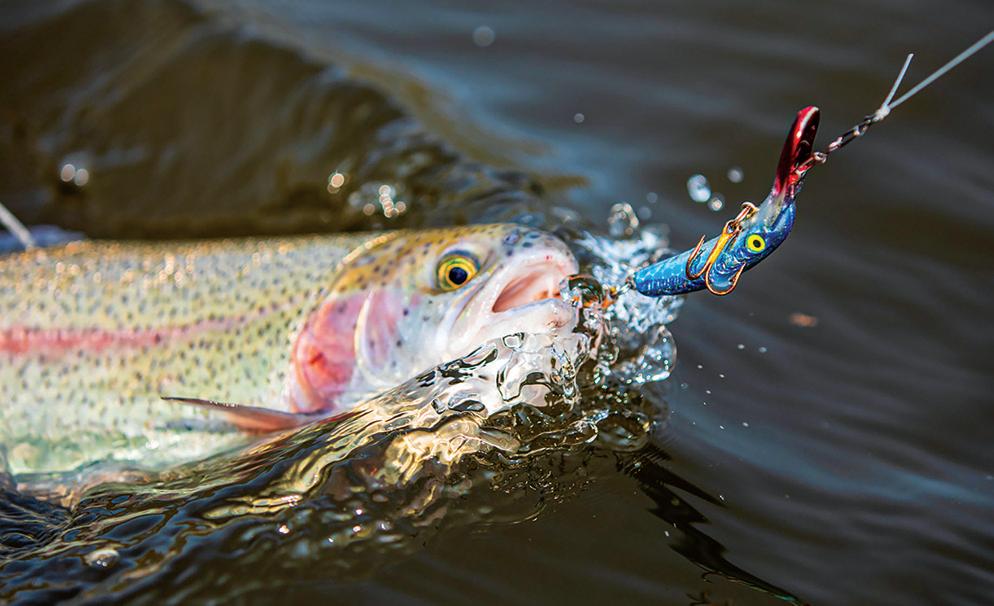
Rounding the corner in the little lake, I was shocked at the level of recreational activity. Kids frolicked in various crafts and enjoyed themselves in the afternoon heat, smack dab in my favorite stretch of trolling water.
But after moving into a secluded arm, I found trout holding where I’d never caught them before. The weeds growing from the bottom were sparse and about 5 feet tall. The trout were
tucked into the middle, seeking cover and cooler conditions.
Rather than troll, my buddy and I switched to fishing floating bait. The bites were subtle but plentiful, and soon we were cleaning our limits.
As summer temperatures increase, people seek relief and fun in rivers and lakes. This human activity often forces trout to move to deeper, more hidden places in lakes and into different holding water in rivers.
Rising temperatures also expedite and increase the growth of weeds, grass, moss and algae, all of which not only impact where fish hold, but dictate where and how anglers can fish. Some places can be hard to fish if overrun by any of these aquatic plants.
Because recreational activity, low water and increased temperatures often force fish to congregate in small areas, fishing pressure in these places can be high. Predator pressure also increases in such areas, as ospreys and cormorants seek food. But there are

Trout is an extremely tasty freshwater fish. Since trout meat is mild, it easily takes on the flavors it’s being cooked with. The key is not going too heavy on ingredients carrying strong flavors or it will mask the flavor of the trout.
To attain the best-eating trout, take proper care of it once caught. These aren’t like bluegill, so don’t put them on

a stringer and dangle them in a warm lake. Trout meat needs to cool quickly. Once caught, kill the fish, snap a gill rake and let it bleed out in the water, then place the fish in a cooler with ice.
Sometimes people complain about the fishy flavor of trout and this often comes down to how the fish was handled once caught – especially improper cooling – not how the cook prepared it.
This recipe is for half of a large trout. Simply multiply the ingredients if you want to cook more fish. Enjoy!
One large trout filet
½ teaspoon granulated garlic
½ teaspoon smoked paprika
¼ teaspoon salt
¼ teaspoon black pepper
¼ fresh lemon
2 tablespoons butter
1 tablespoon olive oil
Chives or scallions, optional
Rinse fish filet in cold water and pat dry. Remove as many bones as possible without damaging the meat. Leave skin on. Cut to desired serving sizes. In a small bowl mix garlic, paprika, salt and pepper. Squeeze lemon juice over meat side of fish filets. Sprinkle spice mix generously
onto both sides of the fish.
In a large skillet, heat butter and oil over medium-high heat. Place fish filets meat-side down and cover the pan. Cook for one to three minutes or until golden brown. Carefully turn filets skinside down and finish cooking to desired doneness. Serve with tzatziki sauce and fresh chives or scallions if desired.
TZATZIKI SAUCE
½ cup Greek yogurt
½ cup grated cucumber
1 teaspoon finely chopped dill or mint ½ teaspoon puréed garlic
In a small bowl, mix ingredients until thoroughly combined. Keep refrigerated until ready to serve.
Editor’s note: For signed copies of Tiffany’s popular book, Cooking Seafood, and other best-selling titles, visit scotthaugen.com.




The Rooster Tail was invented in the 1950s and is still considered one of the top fish-catching lures of all time. Rooster Tails can be casted and retrieved in rivers and lakes, trolled in lakes, even drift-fished and swung in rivers, small streams and creeks.
The pulsating hackle tail, custom blade and detailed paint job of each Rooster Tail body makes it a proven lure, and not just for trout. I’ve caught many species of fish on these spinners, including bluegill, northern pike, king salmon, Arctic grayling and, of course, many species of trout. It’s one of the most versatile lures I’ve used. SH
ways to overcome all that, and now is the time to start thinking about hot weather trout fishing.
When fishing a lake one June, I was catching trout very near the surface by flatline trolling a 3.0 Mag Lip tipped with half of a nightcrawler. Once the sun hit the water, the bite turned off. I was marking lots of trout in the narrow channel, but they’d quit biting and dropped deeper. Between the sunlight hitting the water and the number of cormorants that showed up to fish, the trout went deep.
There was no way to troll through the weeds and they were too tall to run a floating bait in. So I rigged a sliding bobber to fish at 13 feet deep where the trout were holding atop the thick cover. It worked.
Diversifying your approach can result in consistent success when water temps warm and trout are pressured. If trolling a flasher setup with an ounce or two of weight is your go-to rig, that could have limited effectiveness in these conditions.
Flatline trolling – trolling without any weight – keeps a floating plug running shallow so it doesn’t get hung up in the weeds. Casting spinners, floating bait off the bottom and suspending bait from a bobber are also very effective approaches. The key is locating the fish and figuring out which presentation will best reach them.
An overlooked trout approach is trolling with side planers or planer boards. These take your terminal gear away from the boat, which does two things: First, it allows more water to be covered. Second, edgy trout often get spooked to either side of a boat trolling through holding water, and this approach swings wide to pick up fish as they spread out.
Gear can also be run farther back on planer boards, allowing you to target water well behind the boat to catch fish moving back into their holding zone once the boat has passed.




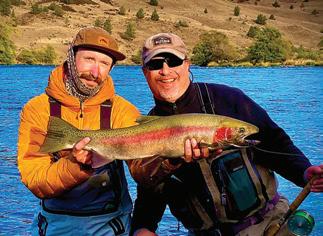
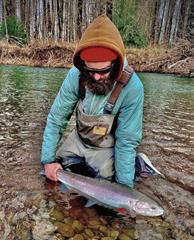



When trout are located, note their depth and figure out the most effective way to get an offering in front of them. Bait changes can make a big difference too. If a worm isn’t working, try dyed corn with scent or a little shrimp. Oftentimes, it’s the smell of baits that can trigger a trout bite. If they sense a different smell in the water, they often react to it and bite.
As summer days heat up, you should fish lakes and ponds early in the morning and in the evening when temperatures are cool and sunlight is not directly hitting the water; fewer recreational users will be on the water at these times also. Move to find fish and don’t hesitate changing offerings if something’s not producing.
Next month, we’ll take a close look at how to target pressured trout in rivers. CS
Editor’s note: Follow Scott and Tiffany Haugen’s adventures on Facebook and Instagram.








The
2.8L displacement and Variable Camshaft
2.8L displacement and Variable Camshaft
Timing

Nearly









I’m not one of those guys who goes fishing but doesn’t eat fish. On the contrary, I’m one of those anglers who often goes fishing to put fish on the table and in the freezer.
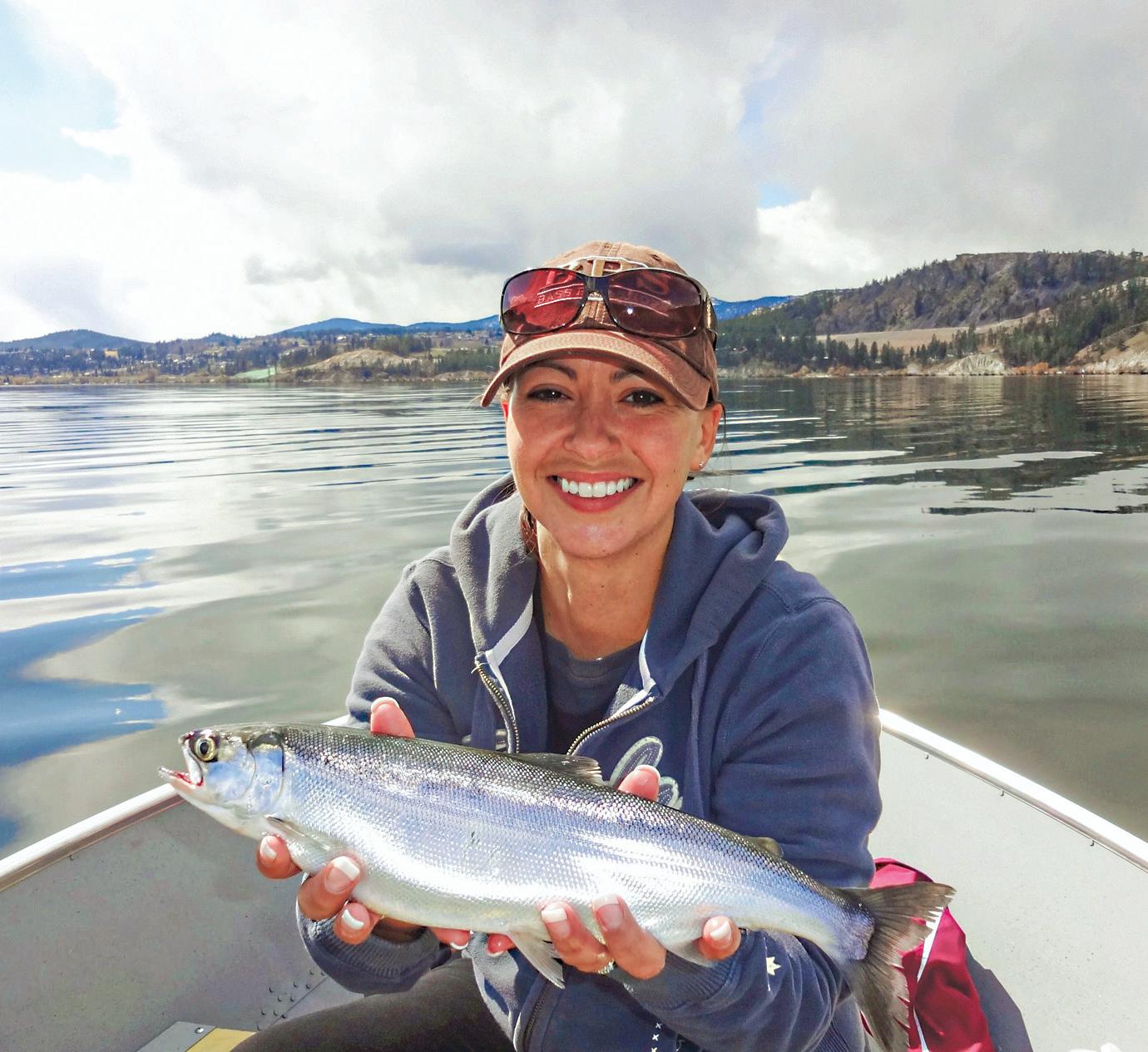
One of the species I really look forward to targeting and eating is oceanrun king salmon, but alas, there will be no tasty Chinook filets coming out of California waters this summer now that a statewide ocean salmon closure is a reality and the Department
of Fish and Wildlife is recommending Central Valley rivers and the Klamath close as well.
What’s a California angler craving some sport and a salmon dinner to do? Drive up to the far-flung waters of Oregon or Washington? Fly to Alaska?

Settle for the farm-raised flavorless salmon sold at the supermarket?
Luckily for us, farsighted conservation groups like Kokanee Power and Project Kokanee, working in conjunction with the California Department of Fish and Wildlife (then known as California Fish and Game), set the stage for Golden State anglers to have constant access to hard-fighting, great-eating salmon decades ago when they fought
to keep kokanee planting a reality in California reservoirs.
You see, while kokanee had been introduced to California waters prior to World War II, in the early 1980s, CDFG was ready to scrap the stocking program, citing cost and lack of angler interest.
Men like Hal Bonslett, founder of the old Fish Sniffer magazine, Dan Bacher, well-known fishery conserva-
tion advocate, and Sep Hendrickson, who would become perhaps the most influential freshwater fishing tackle manufacturer of a generation, recognized the potential of a California sport fishery for landlocked sockeye salmon.
These individuals, along with a long list of others, took action, convincing CDFG to continue kokanee plants. They raised money to help fund the expansion of kokanee stocking. In addition, Hendrickson played a central role in developing light-tackle lake and reservoir trolling techniques and equipment.
Without Hendrickson, those big aluminum sleds arrayed with downriggers and wispy light-action rods that you see dotting reservoirs in Northern and Central California as they ply deep waters for kokanee, landlocked kings and trout likely wouldn’t exist!
While kokanee certainly don’t grow as big as ocean salmon, landlocked sockeye have thrived in Golden State waters over the past four-plus decades, to the extent now


that anglers who like salmon filets featured on their tables can say, “No ocean salmon, no problem! I’ll just harvest a few limits of kokanee this spring and summer.”
AS FUN AS KOKANEE are to catch, they are a quirky gamefish both in what they are willing to strike and in terms of where you’ll find the best fishing from year to year.
The bigger the kokanee, the bigger the fight and the more meat they produce, so anglers are motivated to target the biggest ones they can find. However, big kokanee are a moving target due to their quirky nature.
If a reservoir has too few kokanee, it will produce a few really large
fish, but they won’t exist in numbers large enough to target. Englebright Reservoir in the Sierra foothills east of Marysville is an example of this.
Englebright isn’t planted with kokanee, but a few sockeye from Bullards Bar Reservoir find their way downstream into Englebright. I’ve seen kokanee beyond 20 inches landed at Englebright by trout trollers, but despite repeated attempts, I’ve never been able to target kokanee at the lake. There simply isn’t a big enough biomass of salmon to selectively target them.
On the other hand, at reservoirs such as Bullards Bar, where kokanee are able to spawn naturally in the reservoir’s tributaries, it’s easy for the
salmon to become overpopulated. When this happens you end up with clouds of small fish.
Several years ago, the limit at Bullards was increased from five fish to 10 in an attempt to bring down the total population and increase the average size of the fish, but thus far a big kokanee at Bullards is 12 inches, while rank-and-file sockeye run a diminutive 10 to 11 inches.
For several years, Lake Berryessa was the place to go for big kokanee in the 17- to 21-inch class, but that fishery collapsed and is in a state of rebuilding. Prior to Berryessa wearing the crown, far to the north, Whiskeytown Reservoir was the place to head for a 20-plus-inch silver bullet.
Stampede Reservoir near Truckee was once a reliable destination for 16to 18-inch kokanee before becoming overpopulated with small fish, but recently Stampede has bounced back, and the average size of the salmon being caught has been on the upswing for several years.
THE history lesson. While kokanee can be caught in California during any month of the year, the period between May 1 and the end of August marks the sweet spot of the fishery, when the salmon are at their largest and access is easy even at high-elevation lakes that spend a good part of the year locked in snow.
This being the case, let’s take a deep dive and consider the best lakes for harvesting big kokanee this summer, then I’ll touch on tackle considerations for any rookie kokanee anglers in the audience.
New Melones is going to produce the largest kokanee of the year for California anglers. Kokanee are averaging over 16 inches already and fish approaching 19 inches have been landed. Sockeye exceeding 20 inches should be showing up during June.
New Melones is located in Angels Camp – home of the Jumping Frog Jubilee author Mark Twain made fa-

mous – in Calaveras County on the Stanislaus River. The lake features 12,500 surface acres of water and 100 miles of shoreline when full. The elevation is 1,088 feet when full.
New Melones has down years for kokanee just like every other fishery, but it has a tradition of producing impressive kokes. The largest California kokanee I’ve ever seen grabbed a corn-tipped Apex here during an early 2000s trolling adventure. Measuring over 22 inches and weighing just shy of 4 pounds, it was a magnificent brute that looked like something you’d hook fishing a coastal river in Alaska!
Whiskeytown kokanee likely won’t hit the 20-inch mark this season, but

some will come close. My buddy Captain Kirk Portocarrero has already landed multiple fish between 16 and 17 inches this spring. He told me the salmon are thick-bodied and very energetic.
The lake, located east of Redding off Highway 299 in the Trinity Mountains, offers 36 miles of shoreline and 3,200 surface acres of water. Of the three parts of the Whiskeytown-Shasta-Trinity National Recreation Area, the Whiskeytown Unit is the only one administered by the National Park Service.
President John F. Kennedy visited Whiskeytown Reservoir just before his assassination in 1963 and made remarks about the completion of the dam. An interactive memorial is in place commemorating the visit.
I’ve always enjoyed fishing Whiskeytown’s crystal-clear waters. The lake is almost always brimful. In addition to the kokanee, you’ll also encounter rainbow and brook trout.
Traditionally the Highway 299 Bridge and the area in front of the dam are the best spots to target sockeye.
Stampede’s kokanee are robust spawners; in fact, all hatchery kokanee in California either come from Stampede Reservoir or Lake Tahoe. Since Stampede’s kokanee spawn so successfully, there is always the risk of overpopulation. This situation occurred a few years back, resulting in a massive biomass of







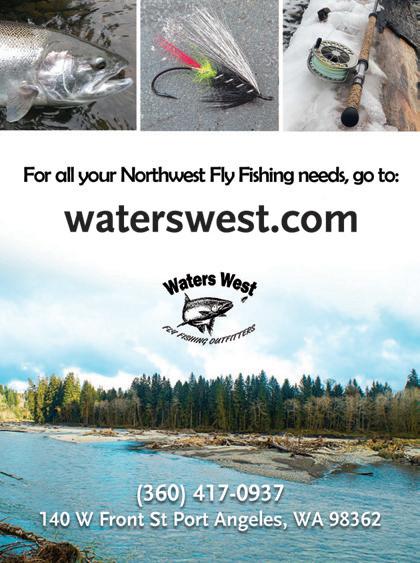

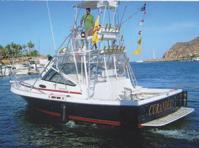



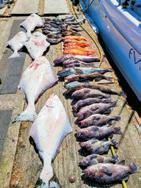






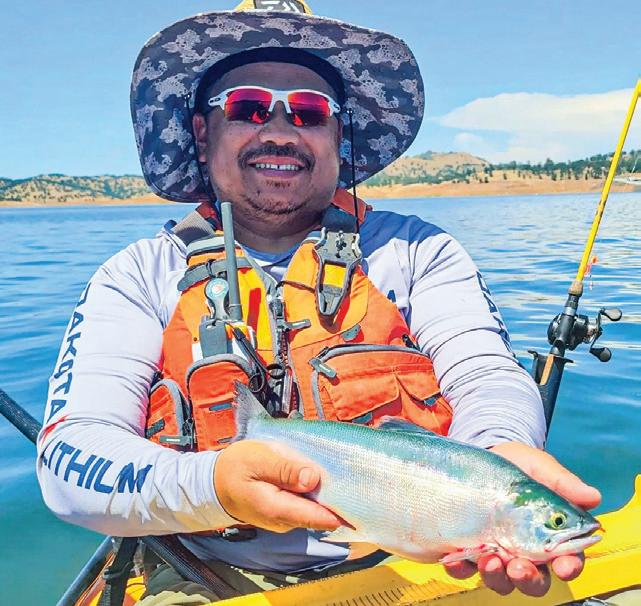
10- to 12-inch salmon.
The days of excess salmon seem to have passed. Last year, the average fish went about 15 inches, with some 16- and 17-inchers caught. This year, Stampede kokanee should add another inch in terms of average size, making for some very exciting action.
Stampede is located a few miles east of Truckee on the eastern slope of the Sierra Nevada. The lake sits at an elevation of about 6,000 feet. With 3,340 surface acres at full capacity, the lake is fairly small by California reservoir standards, but when measured against a lot of other waters at Stampede’s high elevation, it is actually pretty large.
If you are a small-boat angler, be aware that Stampede is subject to stiff winds almost every afternoon during the summer. The bite can be good when the wind is pushing and whitecaps are building, but always think safety when boating in the high Sierra.
Many people consider sockeye to be the finest-eating salmon available, thanks to their sweet, finely textured meat. (CAL
PREFER COLD WATER, so when the surface temperature begins rising in late spring, the fish respond by dropping down in the water column. For this reason, you’ll want a decent sonar unit to locate the salmon and a set of downriggers to get your lures down to the level of the fish.
Electric downriggers are awesome, but simple manual crank downriggers are highly effective and won’t put a big dent in your allowance.
For a lot of freshwater fishing, a fast- or medium-fast-action rod works best, but for kokanee, the most effective and efficient rod will feature a soft, slow parabolic action. Kokanee are savage little sluggers that have an exceedingly soft mouth. A soft-action rod helps to cushion the fight and results in fewer lost fish.
The rod should be balanced with a levelwind reel spooled with 8- to 10-pound-test monofilament.
With rod and reel in hand, you’ll
need a selection of lures. Kokanee are aggressive, but they are also fickle. They will readily strike small spoons, spinners, flies, small hoochies, and hooks adorned with brightly painted resin and which are known as “bugs.”
Orange and pink lures are favorites among kokanee enthusiasts, but it pays to have a wide range of color combinations; kokanee that wanted a pink lure at dawn may prefer a green one later in the morning.
Most kokanee trollers employ small dodgers with their lures, but some use modern low-drag flashers too. While larger dodgers in the 6-inch class work at times, I prefer those from 3 to 4 inches long. These are large enough to attract kokanee to the lure, but not large enough to scare them.
Speaking of not scaring kokanee, chrome dodgers generally work well when the light level is low, but the extreme flash they put off when the sun is high can often frighten kokanee and put them off the bite.
It’s wise to have some blades in colors like copper, gold, pink, orange and watermelon to mix into your spread when the kokanee shy away from chrome dodgers in the late morning hours.
IN CALIFORNIA, ALMOST ALL kokanee anglers tip their lures with shoepeg corn, and it makes a huge difference in productivity. No one is certain why you need to use corn. Some say it adds a pleasant smell to the lure. Others contend that it gives the salmon a target to strike.
A lot of skilled kokanee anglers add scent to their corn. Some days kokanee want shrimp-scented corn; other days they prefer anise. Anise, krill, tuna, herring, sardine, garlic and nightcrawler scents are all proven performers.
I like to bring four Ziplock bags of corn, each bathed in a different scent, so I can determine what is working the best on the day I’m fishing. Be sure to leave some corn unscented. Sometimes, the right corn comes straight out of the can! CS
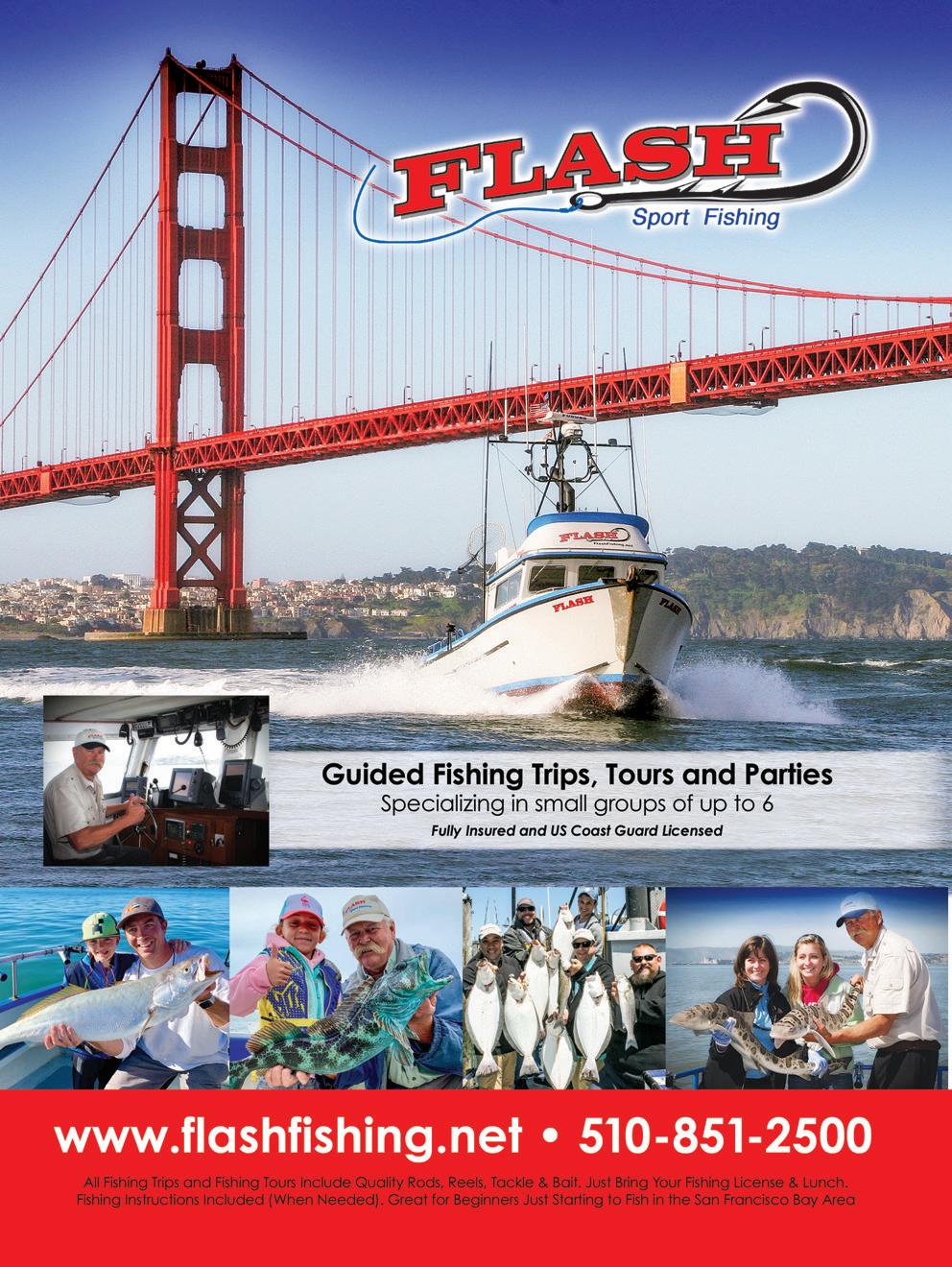
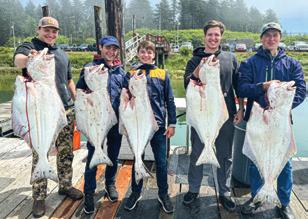
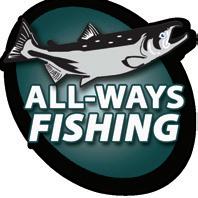





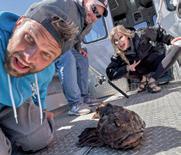
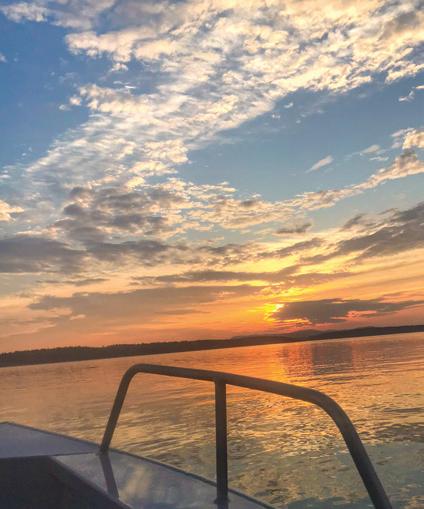





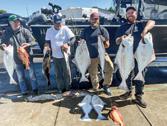
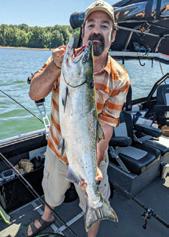

a wily old
a few
When I first started fishing as a kid, it was all about catching whatever I could. In those early years, I wasn’t at all concerned with fishing finesse; I tossed bait, used bobbers and worms and was just focused on hooking and catching fish.
When I fileted my catches, I paid close attention to what I found in their stomachs, and simply used the bait that closely matched what I had observed. It was all about the haul
and what I could drag home.
In my early teens, tired of dealing with messy bait, I started fishing more with lures. I had caught a 1-pound bass at a local lake – my largest at the time – with a Mepps spinner. Thirsting for larger bass, I fished with the same spinner for months, only occasionally catching a larger bluegill or two.
One afternoon, I rode my bike to the lake and started fishing the bank. Across the small pond I noticed an older gentleman fishing as well. Over the next hour I watched him
catch and release half a dozen bass, including one in the 3-pound range. Meanwhile, I unsuccessfully whipped the air with my spinner. During that time, I tried to see what he was fishing with, but he was too far away. I did, however, notice that he would cast, wait and then jig the rod tip a few times before waiting again. Without a bite, I decided to head home. On the way out, I saw the man walking along the entrance road. I asked him how he’d done. He gladly talked to me about his technique and what he used. He’d been tossing a
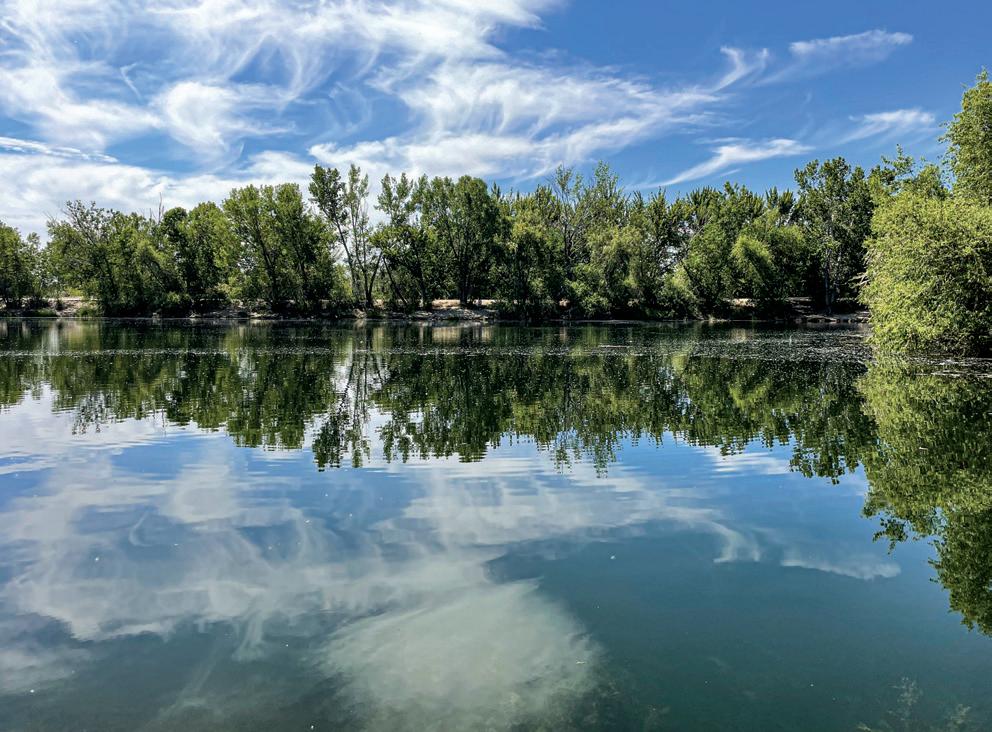
The many small, bass-bearing ponds that dot California are great spots to use this simple technique. “Whenever I was fishing a new body of water, or just looking to fish an area quickly, I’d use the weightless line-watching method,” Hovey writes. (TIM E. HOVEY)

are
small 3-inch worm with no weight. He’d cast the offering out, let it slowly sink to the bottom and then jig it a few times. He’d wait again and repeat the pattern back to the shore. He then stated the one thing that would change the way I bass fish. “You’ve got to watch the line!” he said.
THE FOLLOWING WEEK, I was back at the lake with nothing but a few small plastic worms, one hook and my fishing rod. I only caught two small bass that day, but I was thrilled to see the new technique work. After that, whenever I was fishing a new body of water, or just looking to fish an area quickly, I’d use the weightless linewatching method.
It took me a few years to realize that it wasn’t so much the plastic worm slowly floating to the bottom that got bass to bite. During a weekend trip to a new lake, I started experimenting with different lures in





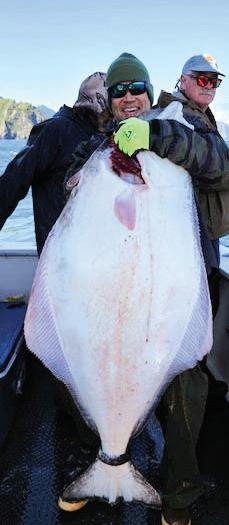
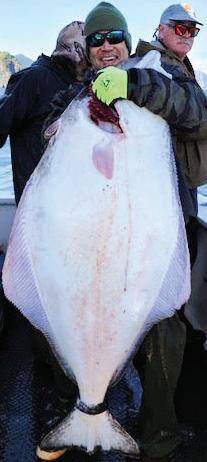

different colors and started to have some success. There is just something about a free-falling, realistic-looking bait that gets bass feeding.
To keep the bait sinking effortlessly, you need to have enough slack in the line to keep tension off the lure. This is where the line watching comes in. As the bait sinks out of sight, watch the line for any indication of a strike or pick up. For me, this is the exciting part. When you see the line start to move, that means a fish has picked up the bait.
As I got more into baitcasting reels, I realized this technique was tough to do with just the weight of a small plastic worm tied to the line. To properly fish this technique, a spinning outfit is best.
Over the years, I’ve settled on a few favorite soft plastic lures that just seem to work better than others. I like white fish imitations and brightly colored plastic worms, with a curly tail. A bait that produces movement as it sinks through the water column to me is a plus. Once the lure hits bottom, I wiggle it a bit and then let it set. If nothing picks it up, I aggressively jig it to the surface and then let it sink again.
Depending on the lure, I’ll rig the hook one of two ways: either through the nose of the bait or wacky-style, through the middle. Plastic worms with curly tails and small fish imitations get hooked through the nose for a more realistic presentation. Straight worms are rigged in the middle so they can bounce a bit, wacky-style.
LAST YEAR, I DECIDED to stop off at a lake near my house. I knew it held smallmouth and largemouth bass, but I hadn’t fished it much. I grabbed my spinning rod and a few Berkley minnow baits.
Fishing weightless, I fished on and near the public dock. The water was a bit cold and not much was moving, but I kept at it. After about an hour, I cast the bait near the dock and watched it sink. When I lost sight of the lure, I kept an eye on the line. I




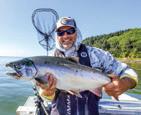




Drastically improve performance and steering of bow-mounted electric trolling motors with the LeeLock Magnum Skeg. The use of bow-mounted electric trolling motors for salmon trolling is a game changer. Not only does this skeg improve performance, it makes bow-mounted electric trolling motors much more efficient. Your batteries will run longer on a charge. The LeeLock Magnum Skeg can be a vital part of your trolling motor system!
The skeg is made of anodized 5052 aluminum. The size is 8 3/4 inches high by 10 inches wide and it’s 3/16 inch thick. The anodization keeps the aluminum from corroding in fresh- and saltwater. The LeeLock Magnum Skeg is available to fit most Minn Kota and MotorGuide (pictured) motors. It comes with clear PVC-coated stainless steel hose clamps. Call 360-380-1864 or write info@ leelock.com if you have any questions about fit.


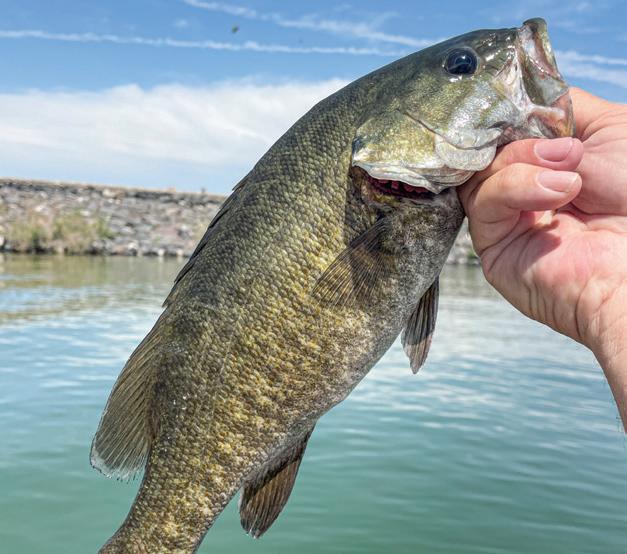
Hovey caught a nice smallmouth on a sinking minnow cast near a dock. “To me, fishing is all about the anticipation.” he writes. “Seeing that line suddenly become animated and start to move will never get old.” (TIM E. HOVEY)
watched as the line suddenly started to move away from the small pier at a 90-degree angle. I reeled in the slack and sharply set the hook. I instantly felt angry pressure on the line.
After a short fight, I grabbed the 2-pound smallmouth in the shallows near shore, the plastic minnow half down its throat. After a few photos, I released the fish.
To me, fishing is all about the anticipation. Seeing that line suddenly become animated and start to move will never get old. Knowing that at that exact moment you’ve fooled a bass is why I use this technique.
If you’re looking to refine finesse bass fishing, try ditching the weight and grabbing just a plastic lure. When bass are hungry, anything hitting the surface will get their attention. If it resembles a food item, they’ll come over to investigate. Even though you can’t feel what they’re doing, that moving slack line will tell you everything you need to know. CS








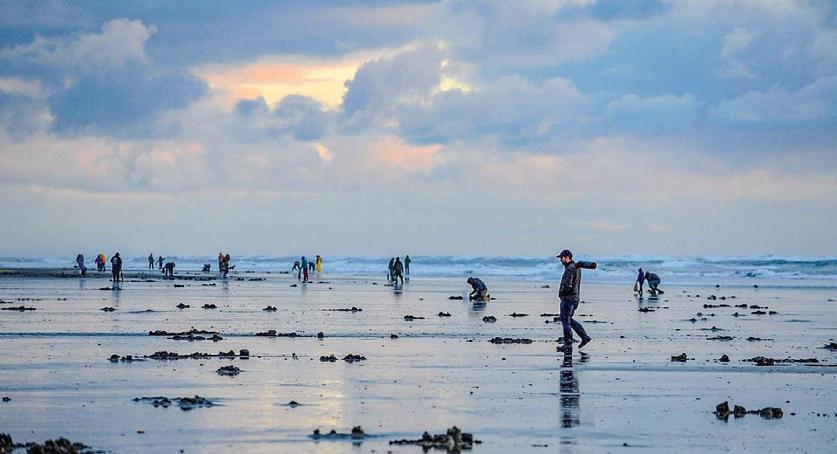


Natural springs are breathtakingly beautiful and fragile ecosystems that exist in harmony with their surroundings, and they support diverse flora and fauna. However, the introduction of nonnative species, such as pet fish, can have grave repercussions on these delicate habitats.
“Here at Ash Meadows, we have historically had a problem with people dumping their pet fish,” said Mike Bower, manager of Ash Meadows National Wildlife Refuge, located just across the California border in Nevada. “I would love to share with the public that even though releasing their pets into the wild comes from a good place in their heart – trying to do what is right by their pet – releasing nonnative pets wreaks havoc for our native species when they become established in these ecosystems.
“We have such high rates of ende -


As these U.S. Fish and Wildlife Service signs suggest, pet fish get dumped into bodies of water far too often. Invasive fish released into lakes and rivers can have devastating effects on native species. (JAKE SISCO/USFWS)
mism that we have species that live nowhere else in the world, and they don't have anywhere else to live. There are no analog systems or habitats for our endemic species to relocate. So we want to ensure that people understand the implications of introducing nonnative animals here at Ash Meadows.”
Natural springs have evolved over
time to sustain a delicate balance amongst the various species that coexist within them. Pet fish that are released into natural springs can outcompete local species for resources such as food, habitat and breeding space. Nonnative fish can grow rapidly and reproduce at high rates, leading to exponential population growth that negatively impacts

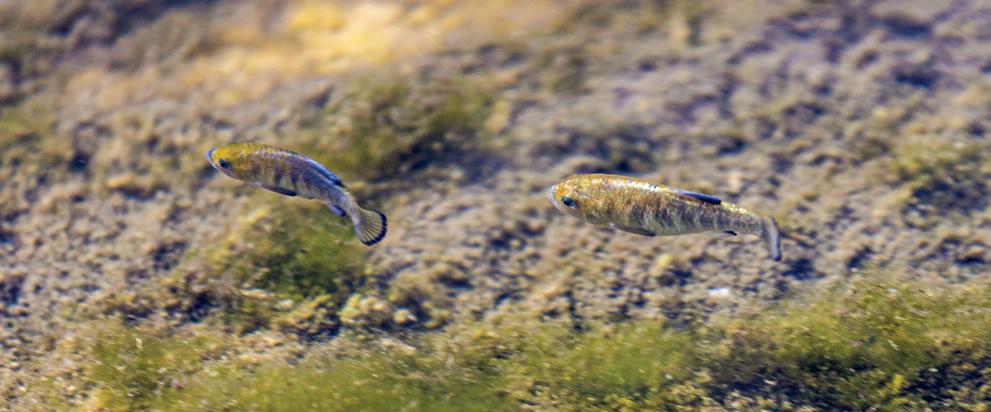
the local aquatic community. This competition often results in native fish populations declining rapidly or even facing extinction, disrupting the natural food chain and impacting other organisms dependent on them for sustenance.
“Besides pet fish, aquatic hitchhikers commonly found in aquariums, such as snails or other aquatic invertebrates, can present a major issue. Once established, these organisms can change the ecosystem from the bottom up,” said Ambre Chaudoin, a fish biologist at the refuge.
“Effects can range from direct impacts to algae and native invertebrate communities to altering nutrient cycling, further affecting native fish and the food community on which they depend.”
The Ash Meadows Amargosa pupfish is endemic to many of the springs and associated marsh habitats of Ash Meadows NWR. This species is quite adaptable, able to thrive in habitats ranging from large spring pools to small seeps and seasonal marshes. In these springs the pupfish is the dominant predator with no defensive

Dumped aquarium pets like this 14-inch goldfish represent an example of what can happen when a pet fish is discarded into a river. “None of our native spring fishes have evolved with predators, so they don’t possess those survival skills required to avoid predation or even compete very well for food resources,” says Ash
mechanism to save it when it encounters a nonnative fish, such as invasive green sunfish.
“None of our native spring fishes have evolved with predators, so they don’t possess those survival skills required to avoid predation or even compete very well for food resources,” said Chaudoin. “I have witnessed pupfish swimming up to crayfish and bullfrogs without any sense of danger or inclination they’re about to become lunch. The western mosquitofish and sailfin molly are smaller invasive fishes ubiquitous on the refuge; they are known predators of fish eggs and larvae. We don’t really have a good sense of how they are impacting our native fishes through predation on these earlier life stages.”
The dumping of pet fish and other species into natural springs can have profound and irreversible consequences on these fragile ecosystems. From preying on the fish to outcompeting them for resources, releasing pet fish into ponds, lakes, streams and springs is not just a bad idea, it is illegal.
Visit dontletitloose.com for information about how to properly dispose of your aquatic pets. CS
Editor’s note: Jake Sisco is a public affairs specialist for the U.S. Fish and Wildlife Service in Sacramento. For more on USFWS, check out fws.gov.

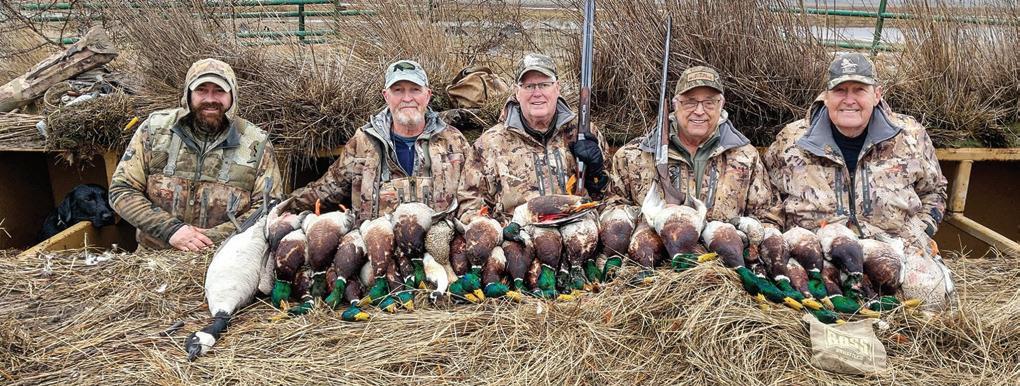











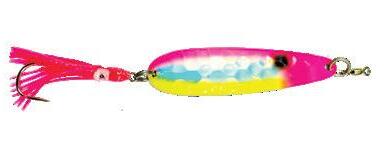





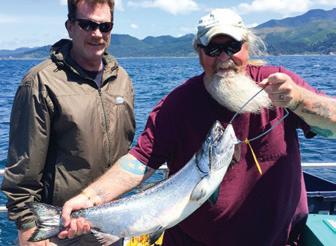
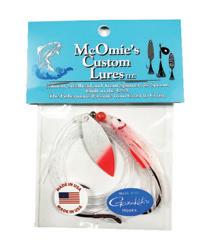
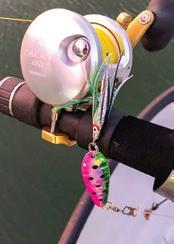
 By Joe Sarmiento
By Joe Sarmiento
Ihave a fishing buddy named Connor Doyle. The first time we met was on a beach in Malibu. I remember that he was slaying big yellowfin croaker on a small Krocodile spoon. He had a couple really good ones attached to his belt.
It was early in my time of learning to fish from the beach – it must have been around 2014 or so – so my approach was pretty basic, using the standard light line, Carolina surf fishing rig and a live sand crab. I caught fish – barred surfperch – but I was really impressed with what Doyle was doing in terms of both productivity and quality of fish caught.
I found out later that Connor played guitar in a band named Borns. I’d never heard of them, but I’m a lover of music. I started a new job in Santa Monica in 2016 and they played a free show on a summer Friday night at Santa Monica Pier.
Wow! They were really good. Next thing I knew they played Coachella. Taylor Swift tweeted about their performance and the rest is history. They had several hit songs and went on a world tour, and Connor and I lost touch for a few years.
Fast forward to spring 2023. Connor reached out to me about a new project. He was living in Long Beach and had started a lure company, Reaper Slow Pitch Jigs (reaperslowpitch.com).
Slow pitch jigging has been on my radar, but I can’t say I’m adept or knowledgeable about it – yet. I wanted to learn more, so I met up with Connor at his boat in Alamitos Bay Marina in Long Beach. After catching up, he provided me with an assortment of his jigs. Most were 150 grams and heavier, but there were a couple tiny ones in the mix – little 15-gram jigs.
“Where do you use these little guys?” I asked.
“They’re great right here in the marina for spotties. I figured you could try them at the Ensenada spot you found,” he replied.
Connor was referring to Estero Beach Resort in Ensenada, Baja Cal-
ifornia. I found the place in September 2022. It was awesome for several weeks, but then winter kicked in. By the next spring, though, there were signs of life. I was excited to see what the new season would bring. Little did I know it would be epic and those little jigs would play a major role.
I made a good friend fishing that spot in Ensenada, Tom Sales. I was in the bar one day having my catch preparee for lunch after a successful morning of fishing when Tom came up and sat a couple barstools away. I told him I was waiting for my lunch of fresh fish and invited him to join me, our bartender and the cook to eat it. Tom sat down with us and I came to find out that he was as much of a fishaholic as I am.

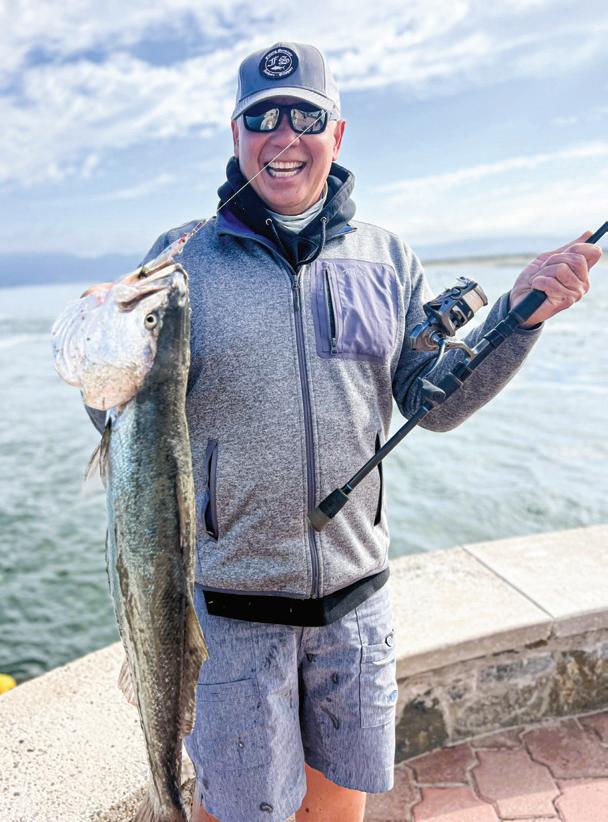
Joe Sarmiento’s shortfin corvina, caught on one of the new mini jigs, came close to an IGFA record. “If you look closely at the almost-record corvina,” Sarmiento says, “you can see what the finished leader looks like.”
(JOE SARMIENTO)
In fact, Tom liked the spot so much that he bought a place there. It was fitting then that the following spring Tom was the first one to make a big score using the mini jig. That halibut ended up being Tom’s biggest one of the year: 33 inches!
And Connor was right: Everything bit the mini jig. Standard fare are the three species of saltwater bass resident there: spotted bay bass, calico bass and barred sand bass. California halibut are always in the mix. The corvina can bite them when they’re
around. There’s also a little baitfish species called salema that loves the mini. We would later learn salema are a favorite food of the local shark population, sevengills and leopards. We discovered bonefish there too. They’re easy to catch when using ghost shrimp as bait. We tried all manner of artificial lures to catch them, but nothing worked as well as the mini jig.
‘KID’ STUFF
Although Tom got the first big score on the mini, allow me to make a case







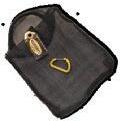





An array of the mini jigs Sarmiento uses. They range from 10 to 30 grams. In the top row are his go-tos: (from left to right): the 15-gram Jigpara in chrome/glow zebra, a 15-gram Reaper in all chrome and a 15-gram Jigpara Slim in anchovy. (JOE SARMIENTO)
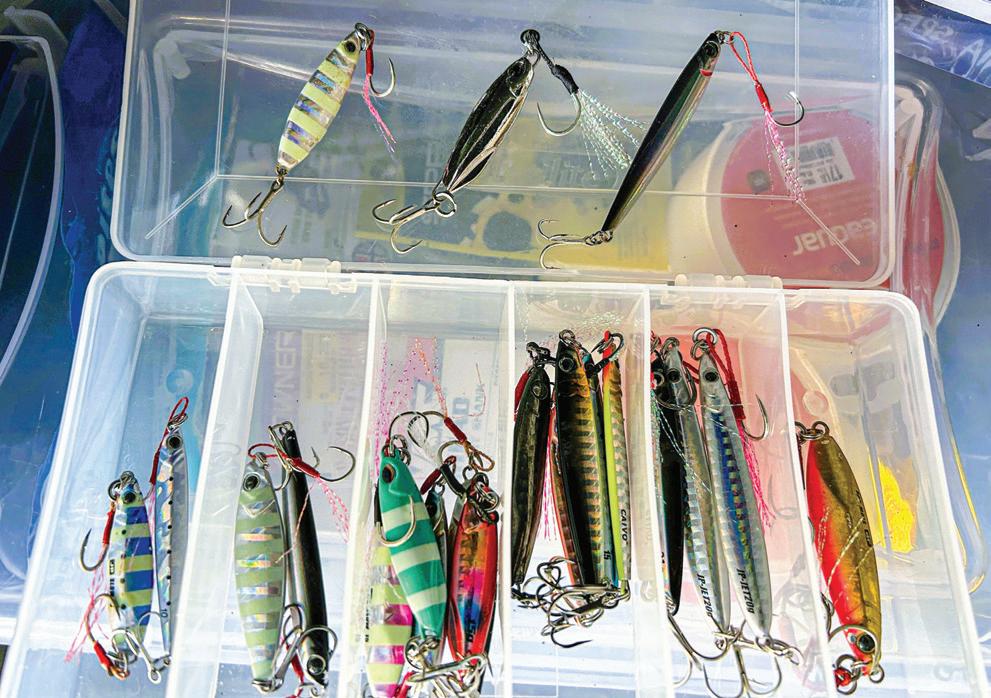
that the best moment of last season was one I had.
We were fishing atop the wall and casting back toward the area we call Kiddie Beach. The tide was an hour or so from hitting low. We’ve found that this tide stage is a productive one. Perhaps the fish realize their forage is washing back out into the bay, sparking them to be more aggressive.
I was doing the standard cast-outand-jig-off-the-bottom method. Connor had told me that if the lure is falling, it’s working, so this was the first method we employed with the jigs.
My lure was maybe 10 feet away from where I was standing. I jigged it up off the bottom and I saw a big shadow swirl on it. Then nothing happened. Did the fish miss it? I
slowly reeled down until I discovered it was still there. When I got tight, a corvina realized it was hooked and made a beeline toward the buoy line that serves as a warning to swimmers to keep inside the protected area.
I ran along the wall toward the beach, winding my reel as I went. I needed to stop and turn this fish before it got my line caught up in the buoy line. When I got its head turned, it leaped out of the water!
I kept the line tight, though, and stayed connected to the fish. It made a couple more mini runs before I eventually beached it – much to my delight and the amazement of the sunbathers on the beach.
Typically, the larger corvina we catch are in the neighborhood of
24 inches, but this one was clearly much larger. We would later find out that the IGFA world-record all-tackle shortfin corvina weighed in at 10 pounds, 6 ounces and was caught in San Diego Bay and measured 32 inches. There wasn’t an IGFA-sanctioned weigh station anywhere close to Tom and I, but for the record, my fish taped out at 31 inches.
After a lot of trial and error, I’ve settled on a standard way to rig up for fishing the mini. My trusty Fishing Syndicate FSG SP 800MH (10-20) is my rod of choice. It is an 8-foot-long spinning rod that fishes heavier than its rating. My reel, usually a 13 Fishing Architect 4.0, which has since been discontin-
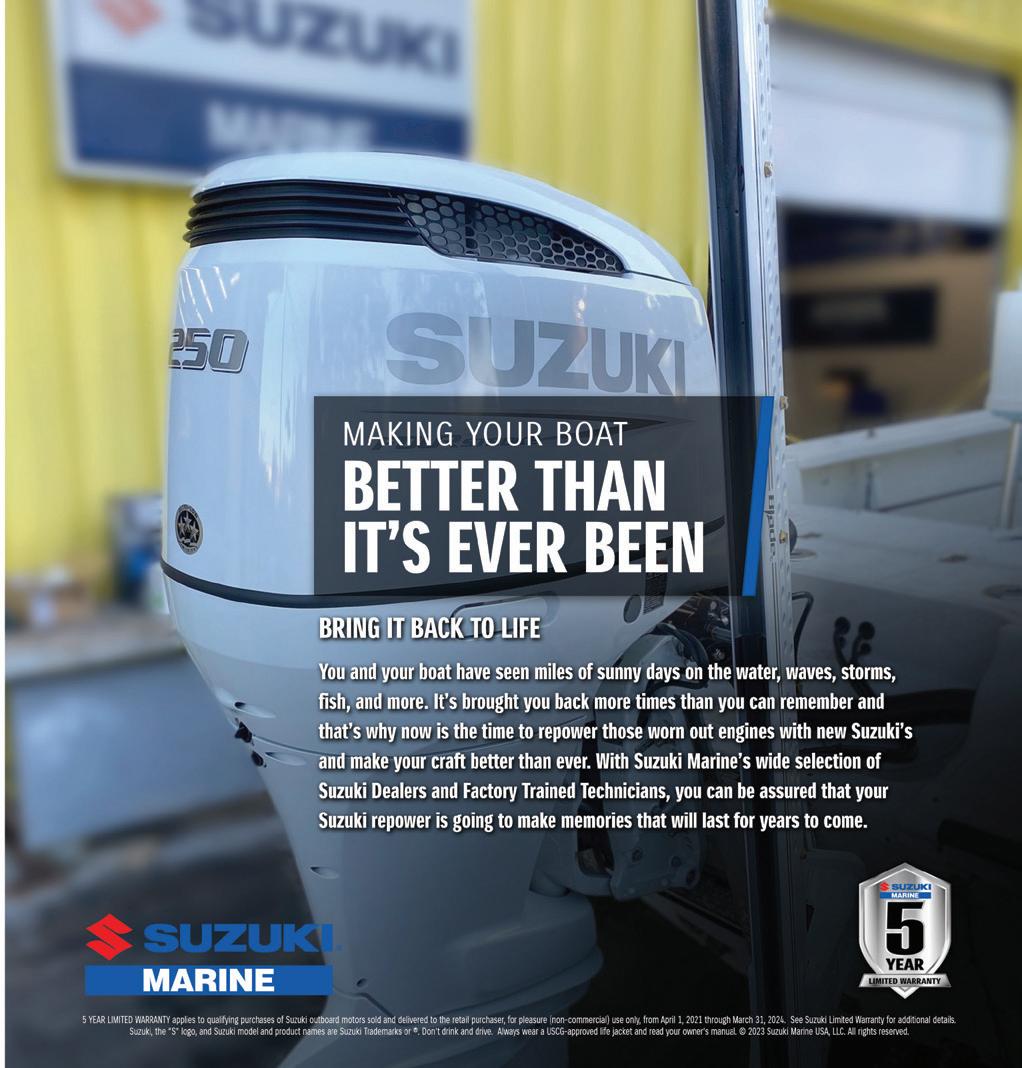


A barred surfperch slammed this chrome mini jig. “Once I’ve determined which way the current is flowing, I’ll cast it against the current and let the mini jig go with the flow,” the author writes. “If I know the spot is mostly sandy, I just let it bounce along the bottom, making sure to keep the line tight as it drifts along.”
(JOE SARMIENTO)ued, is spooled with 40-pound braid. I fish the drags pretty tight (the reel has 22 pounds of drag) because there is a lot of structure in this spot. You really can’t afford to let fish run or they’ll rock you and break off.
I pretie a couple leaders that consist of a 50-pound-rated barrel swivel to about 2 feet of 25-pound Yo-Zuri Hybrid fluorocarbon-coated mono to a 50-pound-rated tactical clip. I use the fluoro-coated mono line because it’s cheaper than straight fluorocarbon. I only want the fluoro for its abrasion-resistance quality. I tie off the mainline braid to my leader, clip on the jig and I’m ready to fish.
As mentioned above, the first way we fished these jigs was to cast out, let it hit bottom, jig it up and let it fall again. Get tight and repeat. I think that action resembles a baitfish that’s struggling and about to die, making it an easy target for a predator to prey upon.
As the season progressed, though, we discovered some other ways that worked too. One of my favorites is
during that outgoing tide scenario I described. I cast upcurrent, let the jig hit bottom and allow the current to take it, occasionally giving the jig a small twitch up to keep it from snagging. That’s the way I caught my halibut.
Tom figured out an effective method for when the water is warmer and our target fish are swimming higher in the water column. After spotting a school of baitfish swimming on the surface, cast at them. When the jig hits the water, immediately start winding to keep the lure up in the water column, then pause. On the pause, the jig will start to sink. I think it looks like a weak member of the school dropping out, ready to get picked off by a predator tracking the baitfish. The jig gets hit when it falls.
This past winter, Connor introduced an all-chrome version of his jig. In the winter months before sand crabs are prevalent on the beach, surf fish such as the various perch, croakers
and corbina tend to bite artificial baits really well. I had a feeling the mini would be effective in this scenario.
In this application, I fish it like how I would with an outgoing tide. Once I’ve determined which way the current is flowing, I cast against the current and let the mini jig go with the flow. If I know the spot is mostly sandy, I just let it bounce along the bottom, making sure to keep the line tight as it drifts along. I want it to go into the troughs and holes where surf predators hide and wait for a tasty morsel to come their way. I was right; the mini works here too.
We’re starting to get to the time of year when fishing is pretty good. Along with the Reaper Slow Pitch mini jigs, another brand I’ve been successful with is Jigpara. I’ve tried other lures, but these two brands are the ones that have produced the most consistent results.
The word is getting out. I suggest you pick up some of these tiny jigs and incorporate them into your arsenal. CS













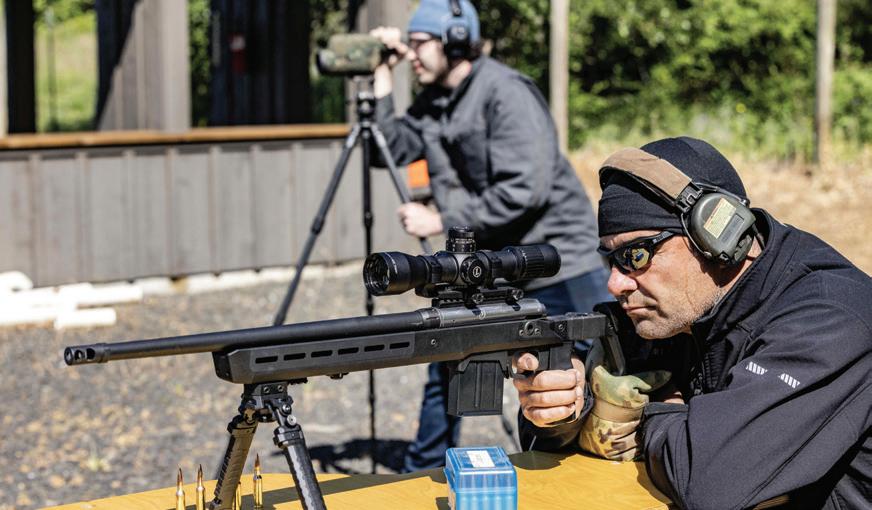



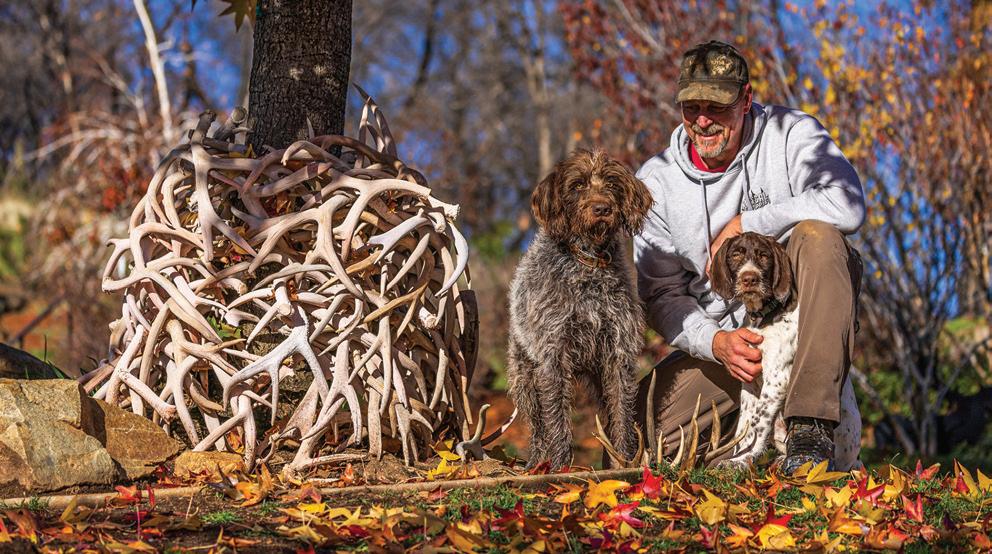
I’d planned on writing my May column on a buddy and how he’s training his German wirehaired pointer pup to hunt for shed antlers. Donn Walgamuth lives in Redding, California. I’ve known him for nearly 10 years and I always love being around him and his dogs. He’s calm, never raises his voice, isn’t animated and his dogs respect him. They watch every move he makes and eagerly anticipate what’s coming next. He’s got the most important
part of training down – building the relationship.
Walgamuth has a new GWP, Hemi. When Hemi was 3 months old, I spent a couple days with Walgamuth as he taught the pup to shed hunt. He tossed out a white deer shed and Hemi retrieved it. Walgamuth gave him a treat and Hemi wanted more. The toss-and-fetch game progressed to Walgamuth hiding the white shed in tall grass, then taking Hemi downwind of it. He walked Hemi into the shed, the pup picked it up and Walgamuth gave him a treat.
Three months later, I chatted with Walgamuth. He’d been sending me photos of all the sheds Hemi and his older dog, Kuiu, age 9, had been picking up.
“The best one was Hemi finding an elk shed,” Walgamuth began. “He smelled that thing in tall grass and thick brush and just kept digging and digging and getting after it!”
“It was amazing to see a 7-monthold pup work that hard,” he added, “but sure enough, he pulled out an old, white spike shed and ran it right to me!”

THAT’S THE MOMENT THE direction of this month’s column changed.
“He smelled that shed?” I asked.
“Oh yeah,” Walgamuth confirmed. “It had rained much of the night and there was a slight breeze in the morning; it was perfect for hunting old sheds.”
Having only sight-trained my dogs to hunt for old, bleached-out big game antlers, I asked Walgamuth to expand on his trick.
“Thirty years ago, my black Lab found an old shed and I put it in the truck,” he elaborated. “Pretty soon the truck smelled like musty socks. I looked around and learned it was the shed. I tossed it out and he immediately picked it up. I tossed it further and he brought it back, fast. He was loving it. That afternoon we worked the wind and my dog found more bleached sheds, and all of them were wet and smelled like dirty socks.”
And that’s when Walgamuth discovered that you could use a dog to hunt for old sheds.
In 1994, he started using his Labrador retrievers to shed hunt. In 2009, he switched to German wirehaired pointers for the job.
“These dogs can cover ground,” he confirmed. “One day last year we found 65 sheds.”
Walgamuth had two adult dogs then. Sage, his pride and joy, passed away at 14 1/2 years old. That’s where Hemi came in.
Kuiu, Walgamuth’s 9-year-old GWP, is a shed-hunting machine.
“These dogs are pretty independent. Hemi has learned to hunt sheds on his own, without the help of Kuiu,” Walgamuth said. “Hemi is already more into winding sheds than Kuiu is.”
“Kuiu is strong on seeing old sheds, which is great; they complement one another well. As white sheds weather, they hold moisture and we love hunting those on misty days,” he stated.
You know that if we can smell a wet, bleached shed, a dog can sniff it out. One weekend Walgamuth’s pointers gathered 88 sheds, about
three-quarters of which were white, old sheds.
“As soon as the dog delivers a shed, I give them a treat and they’re right back on the hunt,” he shared. “They’re very driven and will hunt all day.”
Walgamuth started training with treats. He’d toss a shed in the yard, then later hide it. When the pup brings back a shed, it’s rewarded. The reward is given quickly, calmly, and the dog is right back on the hunt.
He said he and his dogs find a lot of matched sheds.
“Once a pup finds a shed, I’ll mark the spot, then we work in circles,” he shared. “We’ll work a 400- to 500yard radius looking for the other shed. If they don’t find it by then, we move on. Deer can drop their antlers days apart, but a lot of times we find the matches close to one another.”
Right now, Hemi ranges about 200 yards. Pretty soon he’ll be out to 500 yards, then to 800. Walgamuth runs tracking collars so he can keep track of where his dogs are when losing sight of them.
THOUGH THE GRASS IS growing tall and days are warming up, hitting a moist May morning could result in your pup finding some old deer or elk antlers. Get some old sheds wet and practice in the yard. Toss them first, then hide them. The dog needs to learn what they’re hunting for.
If shed hunting in dry habitats this time of year, watch for rattlesnakes. If it’s going to be a hot day, stop early. Also keep an eye out for ticks and always check your dog for them. Be sure and take plenty of water. And remember, just as with upland birds, early morning and evening will be best for shed hunting on hot days, as that’s when most of the scent is near the ground. CS
Editor’s note: Scott Haugen is a full-time writer. See his basic puppy training videos and learn more about his many books at scotthaugen.com. Follow his adventures on Instagram and Facebook.









